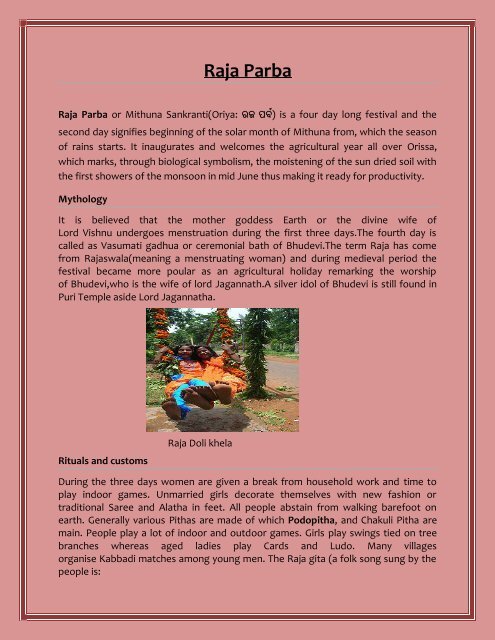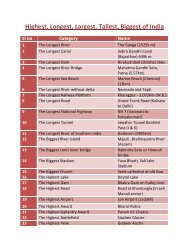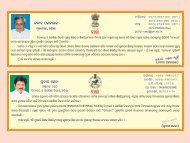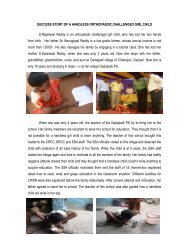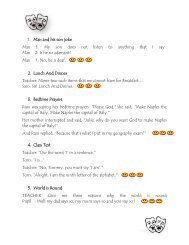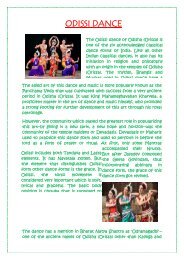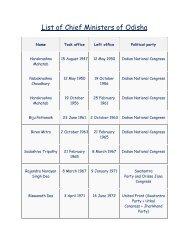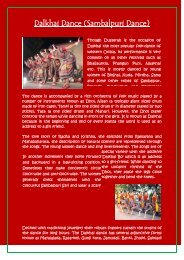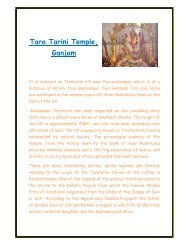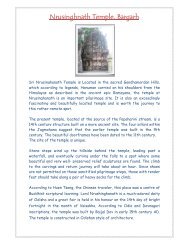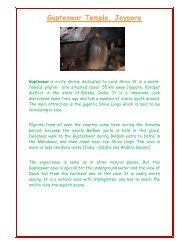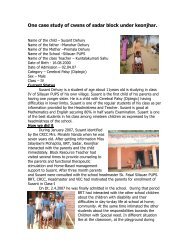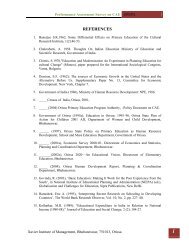Raja Parba
Raja Parba
Raja Parba
Create successful ePaper yourself
Turn your PDF publications into a flip-book with our unique Google optimized e-Paper software.
<strong>Raja</strong> <strong>Parba</strong><br />
<strong>Raja</strong> <strong>Parba</strong> or Mithuna Sankranti(Oriya: ରଜ ପର୍ବ) is a four day long festival and the<br />
second day signifies beginning of the solar month of Mithuna from, which the season<br />
of rains starts. It inaugurates and welcomes the agricultural year all over Orissa,<br />
which marks, through biological symbolism, the moistening of the sun dried soil with<br />
the first showers of the monsoon in mid June thus making it ready for productivity.<br />
Mythology<br />
It is believed that the mother goddess Earth or the divine wife of<br />
Lord Vishnu undergoes menstruation during the first three days.The fourth day is<br />
called as Vasumati gadhua or ceremonial bath of Bhudevi.The term <strong>Raja</strong> has come<br />
from <strong>Raja</strong>swala(meaning a menstruating woman) and during medieval period the<br />
festival became more poular as an agricultural holiday remarking the worship<br />
of Bhudevi,who is the wife of lord Jagannath.A silver idol of Bhudevi is still found in<br />
Puri Temple aside Lord Jagannatha.<br />
Rituals and customs<br />
<strong>Raja</strong> Doli khela<br />
During the three days women are given a break from household work and time to<br />
play indoor games. Unmarried girls decorate themselves with new fashion or<br />
traditional Saree and Alatha in feet. All people abstain from walking barefoot on<br />
earth. Generally various Pithas are made of which Podopitha, and Chakuli Pitha are<br />
main. People play a lot of indoor and outdoor games. Girls play swings tied on tree<br />
branches whereas aged ladies play Cards and Ludo. Many villages<br />
organise Kabbadi matches among young men. The <strong>Raja</strong> gita (a folk song sung by the<br />
people is:
“ ଗଜ,<br />
ଜ<br />
ଜ ଜ ॥<br />
ଜ ଟ ଟ,<br />
ଟ<br />
ଜ,<br />
- ଟ,<br />
ଝ ॥ ”<br />
(Banaste dakila Gaja,barasake thare aasichhi <strong>Raja</strong>, asichi raja lo gheni nua sajabaja'<br />
(meaning the <strong>Raja</strong> carnival has come with the pomp and pleasure of newness)<br />
“ ଟ ,<br />
ଜ ଜ ,<br />
ଗ ,<br />
ଜ ଗ ଜ ॥ ”<br />
(Pana khia Rasika Pati, khoji buluthila <strong>Raja</strong>nka hati, dhali deigala sirare, raja hoigale<br />
rajare (Meaning the while the lucky charming man chewing betel was blessed with<br />
the wondering elephant with the kingship)<br />
Observances<br />
It falls in mid June,the first day is called Pahili <strong>Raja</strong>,second day<br />
is Mithuna Sankranti,third day is Bhu daaha or Basi <strong>Raja</strong>.The final fourth day is<br />
called Vasumati snan,in which the ladies bath the grinding stone as a symbol<br />
of Bhumi with turmeric paste and adore with flower,sindoor etc.All type of sesonal<br />
fruits are offered to mother Bhumi.The day before first day is called Sajabaja or<br />
preparatiory day during which the house, kitchen including grinding stones are<br />
cleaned,spices are ground for three days. During these three days women and girls<br />
take rest from work and wear newSaree,Alaktaka,and ornaments.Its similar<br />
to Ambubachi Mela.


